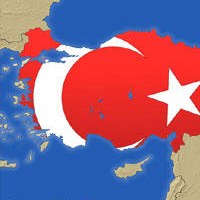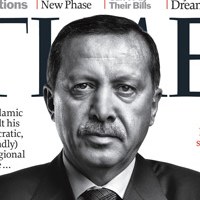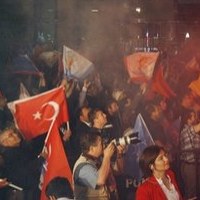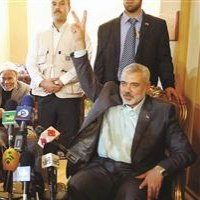![]()
January 2012
This study updates and supplements the ITIC’s June 2011 study of the Muslim Brotherhood. It examines the Muslim Brotherhood in Egypt and other Arab countries in the wake of the past year’s regional uprisings. It deals with the nature of the movement in each country, its relations with the various regimes and evaluates its chances of exploiting regional unrest to its own ends. It also examines the Muslim Brotherhood’s branches in Western European countries and the implications of its activity for both internal European affairs and the Palestinian-Israeli conflict.
Overview
The first Muslim Brotherhood activists came to Saudi Arabia[41] in the first half of the 1950s, when an attempt on Gamal Abdel Nasser’s life estranged his regime from the Muslim Brotherhood, which was accused of planning the assassination. Consequently, thousands of the movement’s members fled to neighboring countries, many to Saudi Arabia. One of them was Muhammad al-Qutb, the brother of Sayyid al-Qutb, one of the major ideologues of the Egyptian Muslim Brotherhood, who turned to radical Islam.[42]
Saudi Arabia was a convenient asylum for the Muslim Brotherhood at a time when Abdel Nasser’s secular nationalism was fighting the Wahhabism of the pro-Western Saudi regime. For the Saudi regime, helping Islamic movements in Egypt disrupt its secular tendencies was an investment in the security of the Saudi kingdom. Furthermore, the Wahhabist school and the Muslim Brotherhood were ideologically close: they were both Salafi movements, i.e., preached that in religious behavior all Muslims should follow the example of the first generation of Islam.
At the time, Saudi Arabia also harbored non-Egyptian Muslim Brotherhood activists. They included Palestinian members of the Muslim Brotherhood, such as Abu Jihad (Khalil al-Wazir), who began his activities in the movement, left Gaza (then under Egyptian rule), and arrived in Saudi Arabia to practice teaching. He later became a Fatah leaders (second only to Yasser Arafat). In 1982 some activists belonging to the Syrian branch of the Muslim Brotherhood fled to Saudi Arabia, after Syria’s President Hafez al-Assad delivered a fatal blow to the movement. Sudanese Muslim Brotherhood activists, including Hassan al-Turabi, also found refuge in Saudi Arabia before joining Jaafar al-Nimeiri’s government.
The Saudi Royal Family’s Approach to the Muslim Brotherhood: Respect and Suspicion
Despite the ideological affinity, and despite the political considerations that motivated the Saudi regime to provide refuge to the thousands of persecuted Muslim Brotherhood activists, the Saudi regime adopted a cautious approach towards the movement’s members and kept them from fully integrating into social and religious life. That was because their ideology was seen as competing with Wahhabiyya, the dominant Saudi religious school. Another consideration was their jihadist bent, reflected in the ideology of Sayyid Qutb and Muslim Brotherhood activists who joined the global jihad, which could jeopardize the Saudi regime’s relations with the United States and even undermine its legitimacy.
Despite its circumspect approach, the royal family did not hesitate to use Muslim Brotherhood activists to its own end. The exiles who found refuge in Saudi Arabia were educated, spoke foreign languages, were exposed to the outside world, and were more politically experienced and sophisticated than the Wahhabi religious scholars (ulamaa), who found it hard to cope with the modern world. For instance, in 1961 the Saudis sought the Muslim Brotherhood’s help in building the Islamic University of Madinah as an alternative to the Al-Azhar University in Cairo, which was tightly controlled by the Nasser regime (some Muslim Brotherhood activists were given senior teaching positions in the Islamic University of Madinah). In the 1960s King Faysal established the Muslim World League to promote the Saudi Wahhabi brand of Islam to counterbalance Nasser’s secularity in Egypt. Members of the league included Muslim Brotherhood activists, and in 1966 it condemned Egypt for persecuting the Muslim members of the movement.[43]
Saudi Arabia plays a major role in funding the Muslim Brotherhood in the kingdom itself and elsewhere. Since its arrival in Saudi Arabia, the Muslim Brotherhood has been generously funded by the Saudi regime. For example, Hermann Eilts, former U.S. ambassador to Egypt and Saudi Arabia, remembered meeting Hassan al-Banna in 1948 in the office of the Saudi deputy finance minister. According to Eilts, Al-Banna often came to Saudi Arabia to receive money. In addition, many Muslim Brotherhood exiles amassed considerable wealth in Saudi Arabia and, in the late 1970s, became important sponsors for Egypt’s Islamist movements.
The Saudis often used the Muslim Brotherhood’s global infrastructure to disseminate their Islamic ideology. In exchange, Muslim Brotherhood activists in Saudi Arabia were given positions and funding. Thus, Saudi Arabia became one of the major centers for the export of radical Islam in the 1970s and 1980s. The number of Islamist (and radical) activists influenced by Muslim Brotherhood ideology who found refuge in Saudi Arabia grew during those two decades. For instance, Sheikh Omar Abdul-Rahman, the blind Egyptian cleric convicted in 1993 for his involvement in the New York World Trade Center bombing, resided in Saudi Arabia from 1977 to 1980 and taught at a women’s seminary. Ayman al-Zawahiri, who began in the Muslim Brotherhood, was given a warm welcome in Saudi Arabia despite his past involvement in Islamic radicalism and the assassination of President Anwar Sadat. In 1986 al-Zawahiri left Saudi Arabia for Afghanistan, where he became Bin Laden’s second-in-command[44] (and succeeded him after he was killed by the Americans). The Palestinian-born Abdallah Azzam, Osama Bin Laden’s spiritual teacher and a major influence on many young Saudis, found refuge in Saudi Arabia. Hassan al-Turabi, the most prominent figure of the Muslim Brotherhood in Sudan, also spent several years in Saudi Arabia.
However, relations between the Muslim Brotherhood and the Saudi royal family remain tense. The royal family is suspicious of the movement, considering it disloyal to the royal family. As a result, the movement was not allowed to establish a branch in Saudi Arabia, unlike most other Arab countries. This suspicious attitude, which provoked conflicts between the Saudis and the Muslim Brotherhood, has become more prevalent over the past decade, particularly after the September 11 terrorist attacks, when Saudi Arabia was accused by the United States and the West of responsibility for the emergence of Al-Qaeda and the growth of global terrorism.[45]
![]()
Read the other sections here:
1. The Muslim Brotherhood in the Arab World and Islamic Communities in Western Europe: an overview
2. The Muslim Brotherhood in Egypt
3. The Muslim Brotherhood in Syria
4. The Muslim Brotherhood in Jordan
5. The Muslim Brotherhood in Algeria
6. The Muslim Brotherhood in Sudan
7. The Muslim Brotherhood in Saudi Arabia
8. The Muslim Brotherhood in The United Arab Emirates
9. The Muslim Brotherhood in Lebanon
10. The Muslim Brotherhood in Morocco
11. The Muslim Brotherhood in Tunisia
12. The Muslim Brotherhood in Europe
![]()
Notes:
[41] This section is based in part on Dore Gold’s book Hatred’s Kingdom: How Saudi Arabia Supports the New Global Terrorism (Washington DC: Regnery Publishing, 2003).
[42] Muhammad Qutb, who settled in Saudi Arabia, edited and published Sayyid al-Qutb’s writings. In due course he became lecturer of Islamic studies at Abd al-Aziz University in Jeddah. His writings included blatant anti-Western themes (Gold, Hatred’s Kingdom).
[43] Gold, Hatred’s Kingdom.
[44] Gold, Hatred’s Kingdom.
[45] The surge of international interest in Saudi Arabian radical Islam, which produced a number of prominent terrorist operatives, has put the Saudi regime at odds with the Muslim Brotherhood. As far as the Saudis are concerned, responsibility for the emergence of the jihadist trend in the kingdom rests with the radical Islam that originated in Egypt and had its source in Sayyid Qutb’s teachings. On the other hand, the Muslim Brotherhood in Egypt has argued that Wahhabism is a fanatic movement responsible for the radicalization of clerics in Egypt and elsewhere in the Muslim world (Ad-Dustour, Egypt, May 2010).



 RSS
RSS











[…] 7. The Muslim Brotherhood in Saudi Arabia […]
[…] 7. The Muslim Brotherhood in Saudi Arabia […]